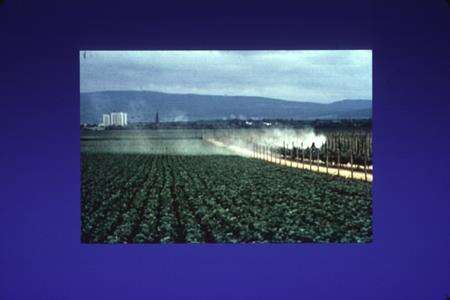By Erdal Ozkan
Due to concerns for production costs, safety, and the environment, it is important to maximize the pesticide deposit on the target. One of the major problems challenging pesticide applicators is spray drift, which is defined as movement of pesticides by wind from the application site to an off-target site. Spray drift accounts for about half of all non-compliance cases investigated by the Ohio Department of Agriculture. Spray drift not only result in wasting expensive pesticides and pollution of the environment, it may damage non-target crops nearby, and poses a serious health risk to people living in areas where drift is occurring.

Although complete elimination of spray drift is impossible, problems can be reduced significantly if you are aware of major factors which influence drift, and take precautions to minimize their influence on off-target movement of droplets. The factors that play a role in either the creation, or reduction of spray drift are: a) Spray characteristics, such as volatility and viscosity of pesticide formulation; b)Equipment and application techniques used for spraying pesticides; c) Weather conditions at the time of application (wind speed and direction, temperature, relative humidity and stability of air around the application site); and most importantly, d) Operator care, attitude, and skill. Here are five cost-effective tips to vegetable producers on how to minimize spray drift.
- If you can, keep your nozzles as close to the target as possible while still producing a uniform distribution of spray on the target. This doesn’t cost any money as long as it is practical to make it happen.
- When you’re ready to change nozzles, consider selecting nozzles that produce much fewer of the extremely small droplets that are most likely to drift away. Low-drift nozzles are in the market and do a tremendous job of eliminating extremely small, drift-prone droplets from the droplet spectrum.
- There are chemicals sold in the market that are designed to increase the droplet size, and reduce the number of very small droplets when added into the spray mixture. Most of them are some sort of polymer that tends to increase the viscosity and density of the spray mixture which leads to larger droplets. This, however, should be the last defense against drift. First consider the other option such as better targeting of the spray and switching to low-drift nozzles.
- Use shields that cover partially or fully the distance between the target and the nozzles. There are companies manufacturing and selling such attachments to the boom. Shields prevent small droplets from moving away from the immediate application area. This, however may not be practical for sprayers with extremely large booms.
- If there is any doubts about a spraying job that might result in drift, wait until there is no longer that element of doubt. Always pay attention to wind direction and magnitude. The best investment you can make is to buy a wind meter that tells you how high the wind velocity is at any given time. Having a wind meter handy will help you avoid a costly problem associated with spray drift.
Source:osu.edu